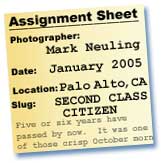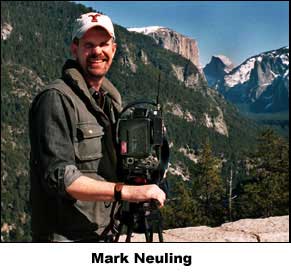Second Class Citizen
By Mark Neuling – Videographer
CNBC – Palo Alto
Five or six years have passed by now. It was one of those
crisp October mornings that we are privileged with here in the
Bay Area. I was attending one of the National Press Photographer
Association’s flying short courses. The list of speakers
that day was impressive. The first to speak that morning
was a Pulitzer Prize winning photographer from the old San Francisco
Examiner. The director of photography from National Geographic
and several other world renowned photographers were slated to speak
throughout the day. Also giving presentations that day were
the television editor and photographer of the year. It was
a stellar line up.
I found my way to a seat towards the middle of the room; as usual
I was ten minutes early. I juggled the free coffee and Danish
on my knees as I scanned around the room. Behind me sat a
couple. There are certain people who gravitate to these professional
events who sometimes seem a bit out of place. I can’t
remember what the woman looked like; maybe it was because the gentleman
was dressed up like he was headed out on safari. He had on
a photo-vest, the type lined with deep pockets and a mesh back;
draped around his neck were two of the latest automatic all-everything
cameras. I’ve never understood the need to bring along
a camera to these seminars, much less two. Was he expecting
to cover a breaking news story? Well there they sat; sipping
their own coffee looking over the order of speakers when the fellow
said something that nearly caused me to choke. “When
the first speaker from the newspaper is done we’ll see if
the TV guy has anything good to say and then we can check out the
exhibits.”
I wanted to turn around and smack the arrogant miscreant. Why
the prejudice against television and specifically TV photographers?
Arnold.jpg)
Just a fraction of the media following
California Governor Arnold Schwarzenegger as he signs
a bill at the University of California, Davis. April
2004.
© Mark Neuling 2005 |
|
That
day was interesting. The still photographers gave wonderful
lectures, they were funny, insightful and articulate. But
there was a certain déjà vu about them. It
was like watching my Uncle Francis show slides about his
last trip to Yosemite. I at least didn’t feel
very engaged; quit honestly these slideshows were a little
boring. But the television clips were a whole other
animal. Wow! They were great. |
| The
television editor of the year shared a compelling piece he’d
edited on the Columbine shootings. The photographer
of the year played a story he’d done on a helicopter
ambulance service and one of their patients. When that
story ended it was as if all the air in the room had been
sucked out. People took a collective gasp. I
think there were even sobs as the story unfolded. This
was television at its best. Television that meant something. Television
that was great story telling, the way television could be,
with all it’s potential realized. Television
that is rarely seen these days even at the network level. |
CBNC.jpg)
Cameraman Dave Koehn sets up a live shot for CNBC outside
Google headquarters in Mountain View, California. August
2004.
© Mark Neuling 2005 |
|
I left
that afternoon being very proud to be a television photographer,
even though I could only match a fraction of the talent that was
present that day.
Amy.jpg)
One of the few camerawomen
in the business, the talented Amy Ocheltree of TechTV
shoots an interview at the premiere
of Star Wars Episode II, San Francisco, California.
© Mark Neuling 2005 |
|
Steve.jpg)
San Francisco 49er quarterback Steve Young is interviewed
by producer Mike Delfino of KICU television. June 4,
1998. The big guy with the camera is the author.
© Mark Neuling 2005 |
|
There
is a website that I like to visit from time to time. It’s
devoted to sports photography. A great site by the
way. But on this website television shooters are
the enemy. We’re referred to as “camera
pointers.” Not videographers, not cameramen,
not shooters, certainly not journalists. I understand
the frustration still photographers have with television. Access
is sometimes restricted because of television’s “rights” to
a sporting event. There are the television cables
and paraphernalia strung along the sidelines to contend
with. Sound people tethered to cameras, cable pullers,
reporters and local news cameramen/women surround the sidelines. There
is a lot of competition for minimal space from which to
shoot. |
Yes
television gets in the way, especially at the end of games. The
still photographers can never understand, why we with our
long lenses, have to rush on to the field after a game
ends to get our jubilation shots. Well we do it for
the same reasons that still photographers do; up close
and personal makes for great television just like it does
for newspapers and magazines. Plus everyone tends
to overlook the fact that television is dependent on sound. The
best way to get good sound is to be close to the source,
and that means being on the field.
|
cluste.jpg)
A cluster of television cameramen are shown here attempting
to get some sound bites after a football game at San
Jose State University, San Jose California. September
2003.
© Mark Neuling 2005 |
|
Consider
for a moment what the people who shoot sports on television have
to contend with. Imagine trying to maintain the concentration
needed to work on something like a college basketball game. That’s
two straight hours of almost total concentration; even during the
commercial breaks there isn’t much time to relax. Add
to that a director yelling in one ear while at the same time trying
to listen to the play by play in the other ear, mix in the added
distraction of comments from the crew on the “party line” and
it’s no wonder that our loved ones think we’re a little
crazy. Once I even had to remove my head set during a game
to answer a question from someone asking what time the game (it
was live of course) was going to be shown on television? Long
hours are also put in setting up and striking cameras, microphones,
cables and monitors. No not as glamorous as shooting for
Sports Illustrated, but still, there is a lot more involved than
just “pointing a camera.”
DNA.jpg)
Cameraman Paul Felt of KICU television shooting footage
for a special on unlocking the DNA code. December 2 1999.
© Mark Neuling 2005 |
|
Even in our own industry shooters are sometimes considered as nothing more than
technicians. Yes we haul the equipment, light the interviews, run
sound, battle antiquated equipment, shoot uninspired stories, put up with
pointless live shots and accept jobs in some markets that barely clear
the minimum wage hurdle. To top it off some reporters and producers
would no more consider us journalists as they would the college intern. But
we can do so much more than simply push the record button on our cameras.
|
Television
photographers are the front line troops in the trench warfare
that is the television news process. We are more
than just technicians. Include us in the story telling
process. The best reporters I’ve worked with
always discussed their story ideas with me. They
allowed me to be part-owner in the story. Television
works best when good people team up to work together. That’s
when great television is made. |
Borg.jpg)
Producer Brian Adams interviews actor Earnest Borgnine
at his Beverly Hills home. Cameraman Ric Shiraki films
the scene from the shadows. July 3 1997.
© Mark Neuling 2005 |
|
Look at
most of the iconic moments that were photographed during the
second half of the twentieth century. The vast majority
of those events were also filmed or recorded on tape. Most
students of photojournalism can tell you that Joe Rosenthal of
the AP photographed the flag raising on Iwo Jima. But
do they know the name of Marine Sergeant Bill Genaust? He
stood next to Rosenthal and shot color movie film of the famous
moment. Genaust lost his life several days later in combat
and is still listed as Missing in Action; yet little credit is
ever given to him for the astonishing segment of history that he
filmed.
As photographers and journalists why don’t we let our New
Year’s Resolution be that a truce is declared between stills
and television? This job isn’t getting any easier. The
competition is no longer just the other newspaper in town or the
local affiliate; it’s now cable and the internet. We
need to get along, compromise and respect our differences. Wouldn’t
it be nice if rest of the world took our lead?
Mark Neuling ©2005
The opinions expressed are solely those of the author.
© Mark Neuling 2005
Email address is now – theneulings@Juno.com
|


Arnold.jpg)
CBNC.jpg)
Amy.jpg)
Steve.jpg)
cluste.jpg)
DNA.jpg)
Borg.jpg)